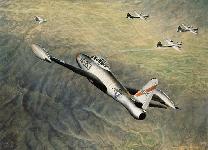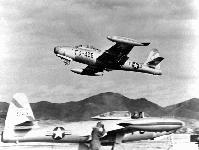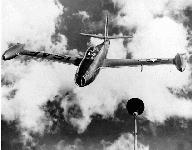







The F-84, conceived as a jet successor to the P-47, was the USAF's first post-war fighter. The prototype's initial flight was on February 28, 1946, and by the time production ceased in 1953, approximately 4,450 "straight-wing" F-84s (in contrast to the swept-wing F-84F) had been built. Many were supplied to allied nations under the Mutual Assistance Program. During its service life, it became the first USAF jet fighter capable of carrying a tactical nuclear weapon. The Thunderjet pioneered aerial refueling for fighter aircraft when aircraft from the 31st Fighter Escort Wing flew nonstop from Turner AFB, Georgia, to the Far East as part of Operation Fox Peter One in 1952.
The Thunderjet saw extensive use during the Korean War, primarily for ground attack and interdiction missions. Almost daily, the F-84s attacked enemy railroads, bridges, supply depots and troop concentrations with bombs, rockets and napalm.
Specifications | |
| Wing Span | 36 feet, 6 inches |
| Length | 38 feet, 6 inches |
| Height | 12 feet, 7 inches |
| Weight | 15,227 lbs. |
| Armament | Six .50-caliber machine guns and eight 5-inch rockets or 2,000 lbs. of bombs |
| Engine | One Allison J35 jet engine with 4,900 lbs. of thrust |
| Cost | $212,000 |
| Maximum speed | 620 mph |
| Cruising speed | 485 mph |
| Range | 1,485 miles |
| Service Ceiling | 43,240 feet |



